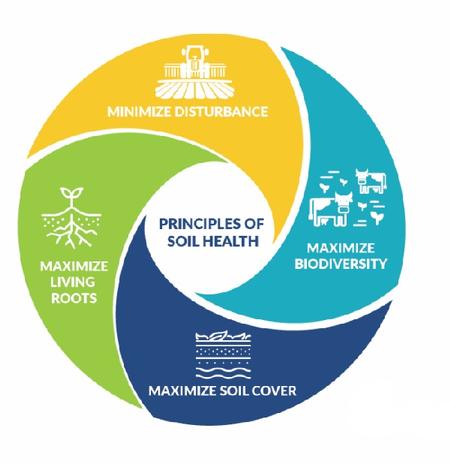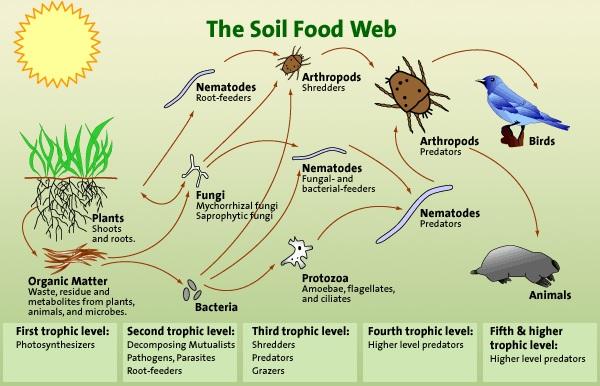
Enriching Garden Soil
Today’s best gardening practices differ from an age-old approach of working the soil. Instead of ploughing and digging, soil science now advises gardeners and farmers to refrain from disturbing the soil in order to preserve the vast web of life beneath the surface. Hidden from view lies an ecosystem of untold numbers of microbes that actively enable plants to grow and thrive.
It has long been known that the soil is home to small vertebrates and insects, but today’s studies are discovering countless species of beneficial bacteria, fungi, algae, and other microbes that are a far stronger force in successful gardening than is a turn of the spade. A billion or more microorganisms exist in a just a teaspoon of soil. Nurturing soil and life within is the basis of nurturing plants that fill our gardens.
What Is Soil?
- In its most basic form, soil is the end result of crushed rock acted upon over time by glaciers, freezing and thawing, erosion, chemical forces, and interaction with plants, animals, and microbes.
- Soil also contains approximately 5% organic matter from plants and animals that have decomposed recently or throughout time immemorial.
- In its ideal form under cultivation, about 25% of a volume of soil is air and another 25% is water; both areas are called pore spaces.
Soil Particles
- Nearly all soils are a combination of materials but are broadly classified as either sand, silt, or clay. Loam combines various amounts of these primary ingredients with the addition of organic materials.
- Sand particles are largest, easily recognizable by size and texture, familiar on beaches worldwide. Sand is generally nutrient-poor.
- Silt particles are nearly dust-like with a slick, silken texture, formed and transported by the action of wind, ice, and water. Silt moves easily in water but also may settle; expansive deposits on land are called loess. Silt has more nutrient value than sand.
- Clay particles derive from mineral-rich rock called silicates. Each particle holds an electrical charge that attracts other minerals before releasing them to plant roots. These particles are individually microscopic but easily adhere to one another, creating a rich but dense material that drains poorly, expands and contracts when moisture content varies.
- Gardeners face the challenge of identifying their soil type. Once known, it can be altered only by the addition of organic matter or small minerals such as perlite or lava rock.
Micro-and Macro-organisms Nurture Soil
- Through a vast underground network, numerous microbial species interact with each other and with plant roots in transporting water, minerals, and carbohydrates.
- Microbes are key for decomposing organic matter, sharing and releasing all essential elements for all life below the surface.
- Microbes, especially strands of fungi, release gummy substances that bind soil particles together into aggregates or clumps. Aggregate formation creates essential pore space that facilitates the movement of water and air throughout the soil.
- Some forms, such as mycorrhizal fungi, interact among numerous plant species to provide nutrients otherwise unavailable for plants to take up.
- Macro-organisms—worms, beneficial nematodes, beetles, sow bugs, centipedes, and others—initially break down materials, eventually die, and are consumed by microbes.
Adding Organic Matter
- Adding compost—decomposed leaves, twigs, straw, grass clippings, manures—is the best way to augment life in the soil.
- Microorganisms feed on organic matter, further decomposing and converting it into simpler forms that plants are able to take up.
- In its final form, compost is called humus, a rich material that soaks up water and contains all essential nutrients for microbial and plant growth.
- To prevent disturbing the underground ecosystem, spread compost on the soil surface or work it into the top few inches. Worms and other soil organisms carry it lower.
Soil Improvement Strategies
- Regular addition of compost provides a continuous nutrient source for all soil life.
- Covering the soil with an organic mulch protects it and the life within from extreme heat and cold. As microorganisms slowly decompose mulch, it must be renewed.
- Including diverse plant species in compost increases the number of available nutrients and enriches soil life for all microbes and plants.
- Home soil testing kits may indicate a suspected nutrient deficiency, but a professional lab test—only when following prescribed guidelines—may be more accurate.
- Preventing soil compaction is as important as refraining from digging. Loose but undisturbed soil allows extensive fungal hyphae and other microbial activity to maintain a stable, undamaged ecosystem.
- No-till gardening also maintains a carbon storehouse underground since all plant parts and all other organic matter are primarily carbon. Exposing carbon to air results in the release of carbon dioxide gas.
Additional Resources
- Tips to improve your garden soil (UC Agriculture and Natural Resources)
- Healthy Soils - Basics (UC Agriculture and Natural Resources)
- Selected Plant and Soil Laboratories (UC Agriculture and Natural Resources)
- The ABCs of Soil Health (USDA ABC’s of Soil Health)
- The Plant Fungi Partnership (UC Agriculture and Natural Resources)
- No-Till Food Gardening
- Green-Manure Cover Crops
- Composting
- Mulch
- Soils, Plant Nutrition and Nutrient Management (Missouri Master Gardener Handbook)
- Soils and Plant Nutrients (North Carolina Extension Gardener Handbook)
 Principles of Soil Health. Image courtesy of USDA Natural Resources Conservation Service |
 The Food Soil Web. Image courtesy of USDA Natural Resources Conservation Service |
November 2022







